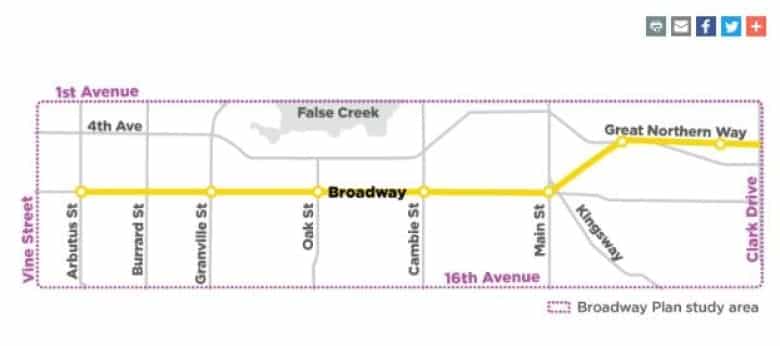A rally was held in Vancouver on Saturday against a draft city plan that would add density to a 2,000-acre area located in the center of the city.
The Broadway Plan, which lays out plans to add housing and workspace to the “second city center,” covers an area from 1st Avenue to the north and 16th Avenue to the south, Clark Drive to the east, and Vine Street to the west.
The area is home to more than 78,000 people, and the plan calls for adding up to 50,000 more residents and an additional 24,000 to 30,000 homes over the next 30 years. It is also home to more than 84,400 jobs, with up to 42,000 jobs added over the next three decades.
Under the plan, mixed-use developments of up to 40 stories can be allowed near SkyTrain stations. The older rental stock could be replaced by 15- to 20-story housing developments with 20 percent of space at below-market rents.
Bill Tieleman, the organizer of the rally outside City Hall on Saturday that included representatives from 20 Vancouver neighborhoods, said the plan would create too much density and change the nature of the city.
“We want to stop the concrete cannons,” he said.
Tieleman says the plan will lead to tenants being displaced as older, more affordable rental housing is torn down to make way for towers.
“They will be unaffordable,” he said. “We already know that new buildings in Vancouver are very unaffordable.”

Owen Brady, director of Abundant Housing Vancouver, says concerns about tenant displacement are legitimate.
“But we also have to worry about displacement because people just can’t find a place to live,” he said.
“We need a lot more apartments. We’re going to have to have higher rises. We’re going to have to have denser buildings.”
Brady said figures from the Vancouver Housing Needs Report suggest that 136,000 households will need adequate housing in the next 10 years.
“We need to act fast and it has to be more than just Broadway,” he said.
Earlier this week, Mayor Kennedy Stewart promised amendments to the plan that would protect tenants if older buildings are torn down and remodeled.
“Relocation of tenants would be a rare event, but these people would be fully compensated with a cash payment or the right to move back to a new building for their current rent or less,” Stewart said.
Stewart said displaced tenants could move back into the remodeled buildings and pay up to 20 percent below market rates.
Andy Yan, an urban planner and adjunct professor at Simon Fraser University, says he has questions about the plan, noting that units in newer buildings tend to be smaller than those in older buildings.
“Will they be similar sized units? Will they be tiny units?” he said. “That’s not necessarily reflected in the details of this plan, but it will have a dramatic effect on these rental neighborhoods nonetheless.”
In a statement, the city said it has listened to residents who want an approach that focuses on creating more housing, supporting the economy and addressing the climate crisis.
The draft plan is scheduled to go to the city council later this month.
On the coast11:08Broadway Rental Protection Measures
Vancouver Mayor Kennedy Stewart joins us to discuss the rent protections for residents living along the Broadway corridor that were announced this morning. 11:08
Reference-www.cbc.ca